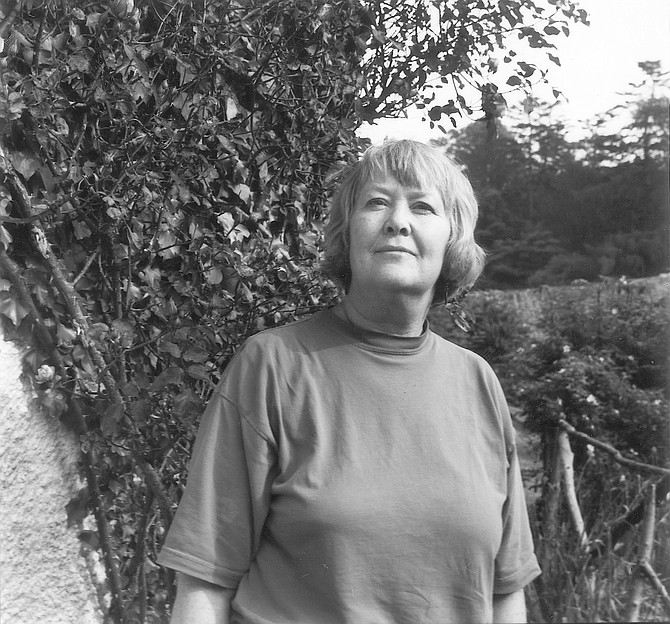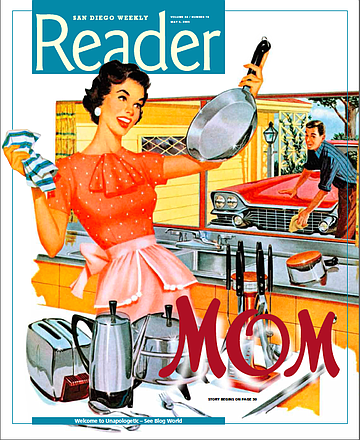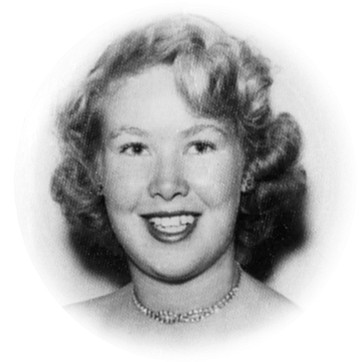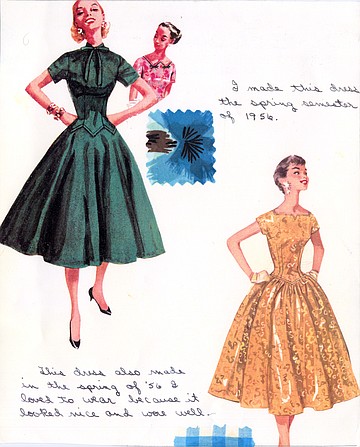 Facebook
Facebook
 X
X
 Instagram
Instagram
 TikTok
TikTok
 Youtube
Youtube


My mother was born in the high desert of northeastern Arizona. Even now it's a hard place to thrive, with rain unlikely and resources few. Her father built their house out of adobe bricks he formed by hand. Her mother sewed quilts out of old clothes, boiled peach pits to make jelly, and scoured the desert to create her garden: petrified wood, round stones, clear glass, broken statuary, wagon wheels, and a bare tree studded with blue bottles, the sight of it gorgeously improbable, as if a camera had caught the moment spouts of blue water turned to ice.

From this my mother learned to make do. She sewed herself off the ranch and into college. In 1956, when she was 19, she sewed two narrow-waisted, full-skirted dresses and pasted the pictures of the patterns into her scrapbook with swatches, saying they "looked nice and wore well." Two years later, she sewed matching striped shirts for herself and the man who became my father, posing for the camera with him, giddily in love. She sewed for one child, then two. When I was four, she made the fringed poncho I wore for a family portrait and sent the picture to my father in Vietnam.

After the war, she sewed scraps of denim together and made my father a jacket. She made a sleeping bag of slippery red and white material that she had to stitch into baffles and then stuff with bags of down so fine that tiny feathers flew all over the sewing room as she pushed them in. She sewed a Pilgrim's dress for me, and I wore it to school just before Thanksgiving, inspiring the principal to show me around the classrooms as a mortified historical exhibit.
Despite this, my mother and I were one at the fabric store. We perched at long tables lined with pattern books and planned what I would wear to school, the sixth-grade dance, my piano recital. Each pattern book sat heavily on a tilted table like the Gutenberg Bible. They could not be moved, so we moved from stool to stool, from McCall's to Vogue to Simplicity, turning the pages very quietly, never seeing my actual self in the clothes, but a sketched icon, the archetype, the ideal.
We took home the patterns in smooth white envelopes, our bags filled with bolts of cloth, button cards, zippers, thread, and needles. Inside the envelopes the pattern pieces were as thin as butterfly wings, folded precisely into forms that would be lost as soon as they were opened.
In the basement room, where the window was at ground level, we cut the gossamer paper apart and weighed down the patterns with heavy steel weights my father had made for us, each square like silver from the mint. Carefully, with the heater ticking beside us and the iron burning the air, we cut out sleeves and yokes, ready to begin the intricate series of seams that would, if we could just sew well enough, yield the archetypal woman in the pattern book.
Outside, it was usually winter. Snow fell, night fell, and stars shown on the fishless waters of the Great Salt Lake. My father got cancer, I went to college, my brother married, I married, my mother got cancer, and still the sewing machine pushed and joined two pieces of thread through two layers of cloth, interlocking over and over, until my father died and my mother was alone in the house, at the sewing table, with all the old white pattern envelopes dark in the drawers, the gossamer pieces of long-ago prom dresses and men's shirts useless now and wrinkled.
She goes to the fabric store alone now. She sits at the tilted tables before the huge pattern books and turns the pages. All is possibility there; the women's faces, red-lipped and angular, have not aged. She takes home new patterns, for herself once again, as when she was 19, and although the snow falls outside the sewing room window, on the fields, tract houses, and my father's grave, she cuts them apart, sets out the heavy weights, and sews.



My mother was born in the high desert of northeastern Arizona. Even now it's a hard place to thrive, with rain unlikely and resources few. Her father built their house out of adobe bricks he formed by hand. Her mother sewed quilts out of old clothes, boiled peach pits to make jelly, and scoured the desert to create her garden: petrified wood, round stones, clear glass, broken statuary, wagon wheels, and a bare tree studded with blue bottles, the sight of it gorgeously improbable, as if a camera had caught the moment spouts of blue water turned to ice.

From this my mother learned to make do. She sewed herself off the ranch and into college. In 1956, when she was 19, she sewed two narrow-waisted, full-skirted dresses and pasted the pictures of the patterns into her scrapbook with swatches, saying they "looked nice and wore well." Two years later, she sewed matching striped shirts for herself and the man who became my father, posing for the camera with him, giddily in love. She sewed for one child, then two. When I was four, she made the fringed poncho I wore for a family portrait and sent the picture to my father in Vietnam.

After the war, she sewed scraps of denim together and made my father a jacket. She made a sleeping bag of slippery red and white material that she had to stitch into baffles and then stuff with bags of down so fine that tiny feathers flew all over the sewing room as she pushed them in. She sewed a Pilgrim's dress for me, and I wore it to school just before Thanksgiving, inspiring the principal to show me around the classrooms as a mortified historical exhibit.
Despite this, my mother and I were one at the fabric store. We perched at long tables lined with pattern books and planned what I would wear to school, the sixth-grade dance, my piano recital. Each pattern book sat heavily on a tilted table like the Gutenberg Bible. They could not be moved, so we moved from stool to stool, from McCall's to Vogue to Simplicity, turning the pages very quietly, never seeing my actual self in the clothes, but a sketched icon, the archetype, the ideal.
We took home the patterns in smooth white envelopes, our bags filled with bolts of cloth, button cards, zippers, thread, and needles. Inside the envelopes the pattern pieces were as thin as butterfly wings, folded precisely into forms that would be lost as soon as they were opened.
In the basement room, where the window was at ground level, we cut the gossamer paper apart and weighed down the patterns with heavy steel weights my father had made for us, each square like silver from the mint. Carefully, with the heater ticking beside us and the iron burning the air, we cut out sleeves and yokes, ready to begin the intricate series of seams that would, if we could just sew well enough, yield the archetypal woman in the pattern book.
Outside, it was usually winter. Snow fell, night fell, and stars shown on the fishless waters of the Great Salt Lake. My father got cancer, I went to college, my brother married, I married, my mother got cancer, and still the sewing machine pushed and joined two pieces of thread through two layers of cloth, interlocking over and over, until my father died and my mother was alone in the house, at the sewing table, with all the old white pattern envelopes dark in the drawers, the gossamer pieces of long-ago prom dresses and men's shirts useless now and wrinkled.
She goes to the fabric store alone now. She sits at the tilted tables before the huge pattern books and turns the pages. All is possibility there; the women's faces, red-lipped and angular, have not aged. She takes home new patterns, for herself once again, as when she was 19, and although the snow falls outside the sewing room window, on the fields, tract houses, and my father's grave, she cuts them apart, sets out the heavy weights, and sews.
Comments